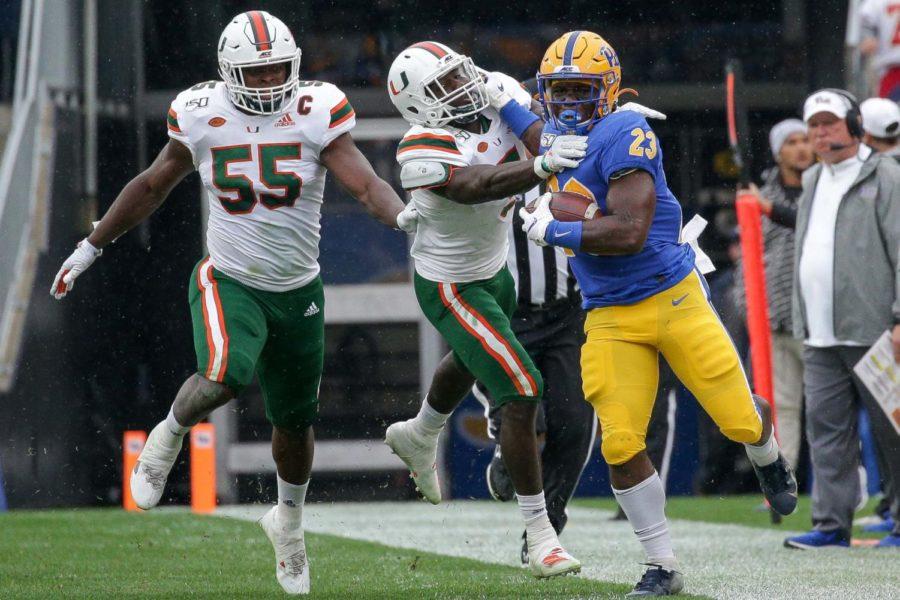Football Takeaways: Panthers suffer self-inflicted setback to Miami
Thomas Yang | Assistant Visual Editor
Redshirt sophomore Todd Sibley Jr. (23) stiff-arms Miami sophomore safety Amari Carter (05) to fight for extra yards before being shoved out of bounds.
October 28, 2019
The past week surrounding Pitt football had been filled with hope and optimism. Talk of New Year’s Six bowls and double-digit wins filled the thoughts, Twitter posts and column inches of spectators and fans. But ominous clouds on Saturday foreshadowed the foggy future that now remains for Pitt following its deflating 16-12 loss to Miami this weekend.
Self-inflicted wounds continue to be an issue
The team from South Florida added a win this weekend, but it wasn’t the Hurricanes that beat Pitt. It was penalties, dropped footballs and conservative play-calling that doomed the home team.
The Panthers were able to move the ball effectively against a typically stout Hurricanes defense, but could not finish drives with touchdowns instead of field goals and turnovers. Pitt’s offense crossed midfield a total of five times, but could only muster four field goals and a fumble on those possessions.
This has been a problem for the Panthers all season long, and held true again this week. Settling for three points — especially during their three red zone trips — will simply not get the job done. Rudimentary math says that one touchdown wins the game, but the Panthers’ offense came up short in the clutch situations which they’ve built a reputation for thriving in.
There were key drops from senior receiver Maurice Ffrench and graduate transfer tight end Nakia Griffin-Stewart, but the offensive line struggled to gain ground in short yardage situations — like on their penultimate drive, when sophomore running back V’lique Carter was stopped at the 1-yard line and Pitt was forced to kick a field goal.
Offensive inadequacy affected defensive strategy
That field goal gave the Panthers a 12-10 advantage and still required the defense to come up with a stop, but six points changes the complexion of the ensuing Miami possession. If the Panthers are nursing a five-, six- or even seven-point advantage, the Hurricanes have no choice but to shoot for the end zone.
Instead, Miami forced the Panthers to play more aggressively and defend against both a field goal and a touchdown. And as a result, Pitt was burned on Miami’s final drive, when redshirt senior receiver K.J. Osborn beat the pressing senior defensive back Dane Jackson for the game winning score.
With a larger lead, Jackson likely would have played in a looser technique that allowed him to keep Osborn in front of him and far from the end zone. From there, the Panther defense’s penchant for forcing field goals when backed up in their own zone would have come in handy. But with Jackson pressed up, Osborn broke one tackle and blew past the safeties who were protecting against the run.
Pitt is not a top-25 team
This loss felt especially frustrating to Pitt fans, considering that the Panthers almost certainly would’ve cracked the AP Top 25 rankings with a win over a formidable Hurricanes team. Pitt received the fourth-most media votes out of any non-ranked team the previous week. With former No. 23 Iowa State and No. 24 Arizona State losing to fall out of the rankings, the No. 25 spot was there for the taking.
It’s fitting, then, that the Panthers didn’t beat Miami and become ranked in the AP Top 25. Because, simply put, Pitt is not a top-25 team.
A top-25 college football program doesn’t shoot itself in the foot at a nationally embarrassing rate. Ranked teams don’t average 7.9 penalties (14th worst in the nation) for 74 yards per game (sixth worst in the nation).
Ranked teams average more than 2.1 offensive touchdowns per game (111th nationally). A team that settles for field goals from within the 10-yard line as often as Pitt doesn’t deserve to be ranked.
Most ranked teams average more than 121.1 rushing yards per game (108th nationally). And the ranked teams that don’t succeed on the ground certainly have a quarterback whose passer efficiency is higher than junior Kenny Pickett’s 115.30, which ranks 102nd out of 114 qualifying passers.
The only reason that Pitt came within a stone’s throw of ranked status in the first place was its defense, which has been thoroughly phenomenal. The Panthers rank 14th nationally in total defense, allowing only 291 yards per game, and first nationally with 4.75 sacks per game.
But having a top-20 defense and a bottom-30 offense isn’t a recipe for consistent success, and that became completely evident Saturday against Miami. After rattling off four straight wins by less than 10 points, it was only a matter of time until the Panthers were undone by their flaws.
Head coach Pat Narduzzi hasn’t won five games in a row in his time at Pitt, and that trend will continue until Pitt’s offense catches up with its defense. When Narduzzi had one of the best offenses in the country with James Conner and Quadree Henderson, the defense was Pitt’s Achilles heel. Now it’s the other way around. So, until the Panthers can boast an above-average unit on both sides of the ball, they deserve to be exactly what they’ve been throughout recent history — a merely decent team on the outside of the rankings looking in,








